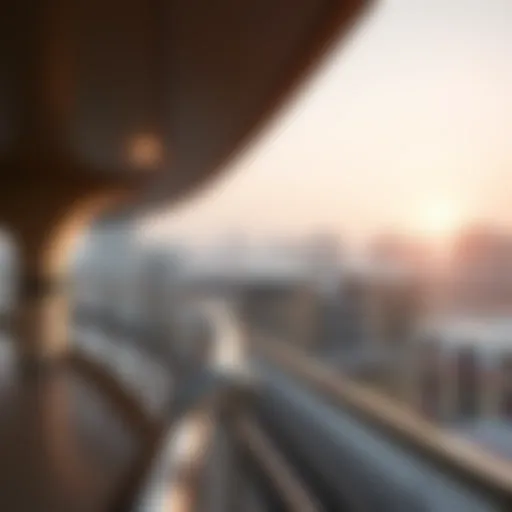Exploring Dubai's Old City: A Blend of History and Modernity
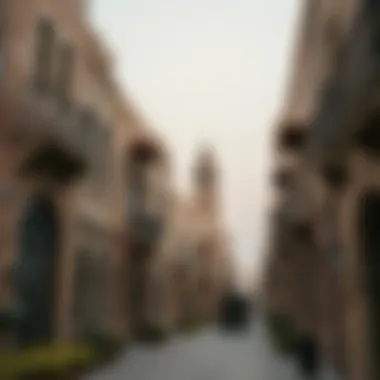

Intro
Located at the heart of one of the world’s most rapidly developing cities, the Old City of Dubai stands as a testament to the rich tapestry of history, culture, and ambition. This area is a treasure trove, revealing layers of Dubai's past—the once-bustling trading hub that laid the foundation for the metropolis it is now. With intricately designed alleyways, traditional souks, and historic landmarks, the Old City offers insights into how Dubai evolved and adapted over centuries.
Today, this fusion of historical architecture and modernity is not merely an aesthetic experience; it also represents significant potentials in real estate. Investors, homebuyers, and culture enthusiasts alike have turned their attention towards the Old City, not just for its charm, but also for its lucrative market dynamics and investment prospects.
As we journey through this multifaceted district, we will uncover its architectural landmarks, explore the current real estate market, identify emerging neighborhoods, and provide guidance on buying and selling properties within this historical enclave. By connecting the dots between the past and present, this article endeavors to present a comprehensive view of the Old City's evolving narrative and its implications for the future.
Historical Significance of the Old City
The historical importance of Dubai's Old City cannot be overstated. This area serves as a testament to Dubai's transformation from a modest fishing village to a global metropolis. The Old City is like a dense tapestry, woven from the threads of trade, culture, and interaction over centuries. As modern skyscrapers pierce the Dubai skyline, it is easy to overlook the rich heritage embedded in the Old City’s narrow alleys and ancient shops.
Origins of Dubai's Old City
The roots of Dubai's Old City trace back to the early 19th century. Initially, it was established as a small settlement along the Dubai Creek, primarily inhabited by fishermen and traders. Local folklore suggests that the location was chosen due to its strategic position as a natural harbor, which facilitated trade routes between the east and west.
Over time, the settlement began to thrive, driven by its bustling trade in pearls and spices. The construction of traditional wind-tower houses, made from coral and mud, encapsulated the Emirati architectural style and laid the groundwork for a vibrant community. Today, remnants of this fascinating past can still be seen in the preserved buildings, showcasing how the region has evolved while respecting its roots.
The Role of Trade and Commerce
Dubai's Old City became a pulsating hub of trade during the 19th and early 20th centuries. The creek served as the lifeblood for merchants transporting goods. Markets, or souks, represented the core of economic life. Goods traded included textiles, spices, and gold, drawing traders from Asia, Africa, and Europe. This fusion of different cultures enriched the local economy and fostered diverse community interactions.
Sustained by this economic dynamism, Dubai developed into a key player in maritime trade. As a result, the Old City is not just an area rich in history; it reflects an evolving economic landscape that supported growth and innovation. The legacy of trade here has direct implications for the real estate market today, as investors often seek properties near historically significant locations where cultural heritage meets modern living.
Cultural Interactions and Influences
Cultural exchanges in Dubai’s Old City have shaped its identity throughout the years. The communication and collaboration between local Emiratis and expatriates from various countries have created a unique societal tapestry that’s unlike any other. This interaction is more than just historical; it influences language, cuisine, fashion, and daily customs that coalesce into a rich culture.
In particular, the Old City hosted an influx of Indian, Persian, and African traders, each contributing their distinct customs and practices. For instance, the vibrant spices in Sharjah Souk reflect Indian influences, while the Arabic calligraphy observable throughout the area tells stories of Islamic heritage and local narratives.
The Old City of Dubai is a living museum, where the past and present intersect. As tourists walk its markets and alleys, they engage in dialogues with the city’s lifeblood—the people. Such cultural richness not only boosts tourism but also enhances community life, making it attractive for new residents and investors interested in diversified experiences.
"The Old City reminds us that behind the shiny facade of modern Dubai lies a deep history filled with stories of trade, culture, and resilience."
Architectural Features of the Old City
The importance of architectural features within Dubai's Old City cannot be overstated. This part of the city serves as a historical tapestry, where the threads of ancient traditions and modern aspirations intertwine. Architectural features not only showcase aesthetic beauty but also embody the cultural, social, and economic narratives of the region. The structures here reflect centuries of development influenced by trade, the environment, and interactions with various cultures.
Traditional Emirati Structures
Traditional Emirati structures in the Old City are a reflection of the country's heritage, displaying unique building techniques and materials suited to the local climate. Wind towers, locally known as barjeels, play a pivotal role in traditional architecture, guiding cool breezes into homes and enhancing ventilation. These structures, characterized by their upward extensions, demonstrate the ingenuity of Emirati builders in creating sustainable living conditions without modern air conditioning.
The buildings are commonly made of locally sourced materials like coral stone or mud brick, which not only provide durability but also blend seamlessly into the landscape. The vibrant colors of the plastered walls, often adorned with intricate geometric designs, hold stories of generations that have inhabited this space.
Moreover, the layout of these structures often centers around a social courtyard, embodying the strong sense of community that has persisted through the ages. Visitors walking through the narrow alleyways are offered a glimpse of daily life from a different time, where the essence of community still echoes.
Modern Renovations and Restorations
As the Old City continues to evolve, modern renovations and restorations have become essential in preserving its historical essence while accommodating the needs of a contemporary society. Remarkably, efforts are made to maintain the original features and charm of traditional architecture, even as buildings are updated for modern functionality.
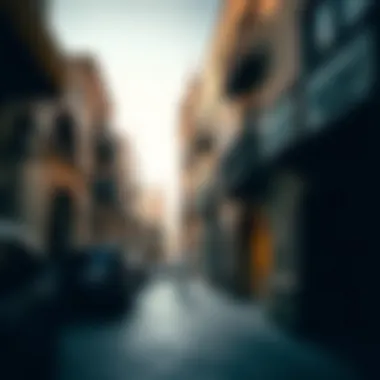

Restoration projects often employ artisans skilled in traditional techniques to ensure that the integrity of the structures is preserved. The Dubai Creek area, for example, has seen revitalization initiatives that balance the old with the new, creating spaces that invite both tourists and locals to experience the rich history while enjoying modern amenities.
Such renovations not only attract visitors but also enhance property values, making the Old City a sought-after destination for real estate investors. The challenge lies in respecting the architectural heritage while implementing necessary updates, thus creating a harmonious blend of the past and present.
Key Landmarks to Explore
The Old City brims with landmarks that tell the tale of its rich past, attracting visitors and residents alike. Some key sites worth noting include:
- Al Fahidi Historical Neighborhood: A must-see for history buffs, this area showcases a collection of preserved buildings featuring wind towers and narrow lanes that transport one back in time.
- Dubai Museum: Housed in the Al Fahidi Fort, this museum offers an extensive look into the region's history, showcasing artifacts and models that depict everyday life in the past.
- Sheikh Mohammed Centre for Cultural Understanding: This center is dedicated to promoting cultural awareness and hots interactive sessions where one can learn about local customs and traditions.
- Gold and Spice Souks: These vibrant markets are a heart of commerce where traditional trade practices thrive. The atmospheric lanes of the souks are lined with shops offering everything from gold jewelry to aromatic spices, showcasing Dubai's trading legacy.
These landmarks do not simply represent points of interest; they are living narratives that illustrate the architectural richness and cultural significance of the Old City. The blend of ancient charm with modern conveniences paints a promising picture for both cultural tourism and real estate growth, making the Old City a compelling focal point for investors.
Social Fabric and Community Life
Understanding the social fabric and community life in the Old City of Dubai is crucial for recognizing its significance in shaping the area’s identity. This vibrant urban zone is not just a geographical location; it’s a tapestry woven from the diverse threads of its inhabitants' lives. The community in Old Dubai reflects a myriad of cultures, traditions, and values that contribute to a rich social landscape. Without a doubt, this lively interplay of customs and everyday interactions forms the backbone of communal life.
The Diverse Population of Old Dubai
Old Dubai is home to a kaleidoscope of residents, transcending nationalities and backgrounds. The traditional Emirati community coexists with expatriates from various corners of the globe. From people previously living in the Gulf regions to others from over 200 countries, the demographics here paint a picture of diversity. Each group enriches the community with its unique traditions, beliefs and cuisines.
Notably, the local Emirati population upholds their rich heritage, while newcomers foster cross-cultural exchanges that spur innovation and adaptation. It is not uncommon to see Emiratis and expats participating in neighborhood gatherings, creating an effervescent atmosphere that thrives on cooperation and mutual respect.
"The beauty of Old Dubai lies in its ability to bring together people from myriad backgrounds, each contributing to a collective narrative of growth and resilience."
This diverse population is also an economic boon, as it offers a wide-ranging labor force and promotes a dynamic marketplace. Local businesses, restaurants, and trades benefit from this varied customer base, ensuring that the economy sees continuous development while social interactions remain vibrant.
Festivals and Cultural Events
Cultural festivals play a pivotal role in the community life of Old Dubai, serving as monumental occasions that allow diverse segments of the population to connect. Events like the Dubai Shopping Festival and the Diwali celebrations in the Old City draw crowds from all walks of life, promoting a spirit of unity through festivities.
Throughout the year, one can witness colorful parades, traditional music performances, and exhibitions showcasing local artisans. Such events furnish a platform where both Emirati traditions and the cultural practices of expatriates interweave, generating exciting collaborations that resonate with all community members.
Moreover, local mosques, art galleries, and cultural centers often host workshops and lectures, further enriching the communal tapestry. Such establishments invite residents to participate in learning experiences that strengthen understanding of diverse cultures, thus enhancing community harmony.
Role of the Old City in Modern Society
In today’s fast-paced world, Old Dubai holds a significant role in modern society, acting as a bridge between the past and the present. The Old City serves not only as a historical reference but also as a living community that showcases resilience in the face of evolving societal dynamics. Various modernization efforts have infused the area with new life without losing the essence of its heritage.
The Old City functions as a cultural hub, attracting tourists and locals alike, which, in turn, stimulates economic growth. The presence of markets like the Spice Souk and Gold Souk offers a robust shopping experience, showcasing traditional Emirati craftsmanship and global merchandise. Coupled with residential areas, the Old City fosters a sense of belonging, balancing the dynamics of urbanization with cultural preservation.
In essence, as society evolves, the Old City continues to be a critical element in understanding the identity of Dubai. It encourages dialogue about cultural values and modern aspirations, making it a focal point for community engagement, tourism, and investment.
Economic Impact on the Real Estate Market
The significance of the economic impact on the real estate market within Dubai's Old City cannot be overstated. This area melds rich history with burgeoning modernity, and the interaction between the two generates a unique economic atmosphere. Investors, property developers, and homeowners find themselves drawn to the Old City for its promise of cultural authenticity and commercial viability. This section examines crucial elements that shape this landscape, along with the considerations investors must keep in mind.
Investment Trends in the Old City
Investing in the Old City has seen an uptick over the last few years, attributed to a growing interest in heritage and culture among buyers. Many view the Old City as more than just a location; it's a chance to partake in its history while securing a potentially lucrative investment.
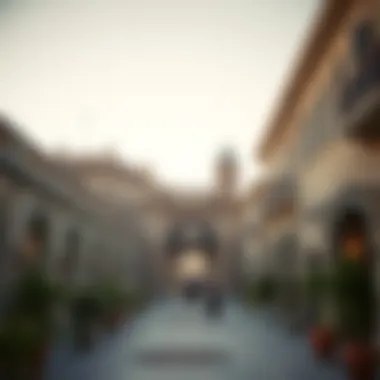

- Local Interest: Residents and expatriates alike are increasingly keen on buying properties in historic neighborhoods. The unique charm and narrative attached to each building add emotional value.
- Regulatory Support: The Dubai government is actively promoting investments in this area, often introducing favorable regulations that make it easier to acquire and develop properties.
- Gentrification Effects: As a rising interest in the Old City grows, gentrification is becoming a double-edged sword. While it may elevate property values, it also risks displacing long-standing residents.
This influx of investment reflects a longing to recapture the essence of what Dubai once was—a bustling hub of trade and diversity.
Property Value Dynamics
Delving into property values, one notices an interesting juxtaposition between historical and modern valuations. Traditional homes in the Old City maintain value due to their rarity and cultural significance, while modern developments attract premium prices.
- Appreciation Rates: Properties in the Old City have generally experienced healthier appreciation rates compared to surrounding areas. This trend is largely driven by a limited supply of historical properties paired with increasing demand from buyers interested in unique architecture.
- Comparative Analysis: Compared to newly developed regions in Dubai, properties in the Old City provide more than mere shelter—they offer a tapestry of stories and cultural relevance that appeals to both investors and tourists, bolstering their market worth.
- Renovation Investments: As old structures undergo renovations to meet modern standards, they not only demand higher rents but also boost the overall property market within the Old City.
Impact of Tourism on Real Estate Development
Tourism plays a pivotal role in shaping the real estate landscape of Dubai's Old City. As visitors flock to experience its unique offerings, several implications emerge for real estate development.
- Increased Demand for Short-term Rentals: With the rising popularity of platforms like Airbnb, property owners have started focusing on short-term rentals. This shift has the potential to enhance returns on investments significantly.
- Commercial Opportunities: The influx of tourists boosts commercial real estate. Shops, cafes, and cultural spaces are cropping up, designed to cater to visitors searching for authentic experiences.
- Potential Strain on Local Resources: As tourism increases, the local infrastructure may face strains. Property developers must consider sustainable practices and community needs alongside their economic ambitions.
The Old City of Dubai presents a unique investment landscape shaped by its historical richness, residential demand, and the ever-present flow of tourists. Investors can find a balance between appreciating historical value and harnessing modern economic potential in one of the most dynamic cities in the world.
In summary, the economic implications on the real estate market in Dubai's Old City reflect a complex interplay of heritage, modern aspirations, and the global demand for cultural experiences. The area is no longer just a relic of the past; it stands as a modern-day testament to opportunity, awaiting the right minds to unlock its full potential.
Challenges Facing the Old City
The Old City of Dubai, steeped in history and cultural significance, faces a plethora of challenges as modernity knocks at its door. While the rapid development surrounding it presents significant opportunities for enhancement and growth, the balancing act between preservation and progress is crucial. The vibrancy of everyday life in this historic space is delicately intertwined with its past. Hence, understanding these challenges provides a lens not merely for preservation but also for strategic investment and revitalization.
Balancing Preservation and Development
Striking a balance between the old and the new isn’t just a task; it’s a responsibility. As stakeholders look to the future, the need to preserve the Old City’s unique character becomes paramount. Many traditional establishments, such as the Al Fahidi Historical Neighborhood, serve as living testaments to Dubai’s rich heritage. However, the encroaching development pressures this historical fabric.
Investors and developers must consider the following:
- Historic Significance: Many of these structures are not merely buildings but part of the soul of Dubai. Preserving them can enhance the cultural tourism sector.
- Modern Needs: Integrating modern amenities without compromising historical aesthetics is tricky yet necessary for attracting today’s residents and business owners.
An effective strategy could blend innovative design with traditional architectural elements, enabling preservation while still accommodating modern needs. A well-executed project can exemplify how contemporary structures may harmonize with historical sites, thus preserving the essence of the Old City for future generations.
Environmental Considerations
With growth comes responsibility for the environment. Urbanization can exert tremendous pressure on local ecosystems and biodiversity. The Old City is not exempt from environmental concerns, given its proximity to both the harbor and natural desert landscapes. The challenge here lies in developing sustainable practices that account for the local environment, which is often overlooked in rapid development scenarios.
Key considerations include:
- Resource Management: Efficient use of water and energy is critical in a place where the climate can be harsh. Solutions such as solar energy panels or water-saving technologies could be integrated effectively.
- Waste Management: Ensuring that increased footfall doesn’t lead to heightened waste generation is another hurdle to address. Effective waste management strategies should be prioritized.
The Old City must spearhead efforts to incorporate sustainability into its redevelopment plans. By establishing green spaces, promoting pedestrian-friendly areas, and utilizing technology for efficient resource use, it can serve as a model for responsible urban growth.
Socio-Economic Disparities
The socio-economic landscape in the Old City is complex and often marked by disparities. As newer developments flourish, the gap can widen between affluent newcomers and long-standing residents facing rising costs. This issue does not merely affect daily life but can also lead to cultural erosion if traditional communities are displaced or marginalized.
Important aspects include:
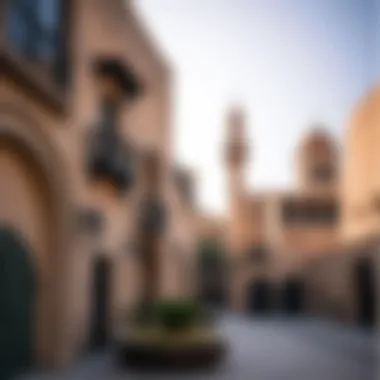

- Gentrification Risks: As property values soar, existing residents may find themselves priced out. Investors must tread lightly, ensuring that community displacement is kept at bay.
- Cultural Accessibility: Increasing property costs can deter local businesses from thriving, leading to reduced cultural exchanges that once flourished between different ethnic groups.
To confront these disparities, initiatives aimed at preserving local culture, maintaining affordable housing, and supporting small businesses are crucial. This balance will sustain the community's essence while allowing it to evolve.
"Preserving the past while adapting to the future is not just ideal; it requires a concerted effort from all stakeholders involved."
For more insights on the development prospects in urban settings, a resource like Britannica could offer valuable perspectives.
Future Prospects of Dubai's Old City
The future of Dubai's Old City holds a tapestry of potentials that intertwines historical significance with modern ambitions. As stakeholders, investors, and the local community scrutinize this area, it becomes evident that understanding future prospects is vital. This section unfolds several layers, from urban renewal projects that honor the past to innovative designs and substantial investment opportunities. All these elements together can reshape how we view the Old City, both as a cultural emblem and a commercially viable locale.
Urban Renewal Projects
Urban renewal projects in the Old City aim to rejuvenate its districts while paying homage to its heritage. These undertakings involve careful planning and execution to ensure that any new development respects the city's traditional layout and architectural style.
Some notable projects include:
- Deira Waterfront Development: This initiative seeks to enhance public spaces and improve the waterfront area with parks, retail outlets, and cultural sites. Designed to attract both locals and tourists, it reflects the integration of contemporary urban living with historical appreciation.
- Restoration of Heritage Sites: Buildings like the Al Fahidi Historical Neighborhood and Dubai Museum are undergoing significant restorations to showcase their original glory, alongside modern amenities.
- Green Spaces Initiatives: Creating parks and gardens can transform congested areas into breathable spaces, making the Old City more attractive to residents and visitors alike.
These urban projects are not merely about aesthetics; they can also stimulate local economies and create job opportunities, making the area more vibrant and interactive for all.
Innovative Architectural Concepts
The Old City of Dubai is poised to witness a slew of innovative architectural concepts that blend traditional designs with cutting-edge technology. Here are some fascinating ideas being tossed around:
- Adaptive Reuse: This strategy involves repurposing old buildings for new functions, ensuring the preservation of Dubai’s rich history while adapting to modern needs. For instance, converting old markets into boutique hotels or art galleries adds charm and utility.
- Sustainable Materials: New developments are beginning to embrace sustainable practices, such as using local materials that echo the region's heritage, minimizing the environmental footprint of construction.
- Smart Technology Integration: Concepts like smart buildings equipped with energy-efficient systems and IoT solutions are in the pipeline. These innovations can enhance living conditions while preserving the city's historic charm.
Such architectural advancements not only pave the way for modern functionality but also ensure that the historical essence remains intact.
Investment Opportunities for Stakeholders
Investing in the Old City presents unique opportunities for various stakeholders. Potential investors, be they individuals, real estate agents, or large firms, can leverage the following aspects:
- Cultural Tourism Growth: With the Old City drawing tourists for its historic sites, the potential for profit in hospitality and retail ventures is palpable. Investors can capitalize on this trend through strategic positioning and thematic offerings.
- Real Estate Development: With urban renewal and restoration projects ongoing, there exists an opportunity for profitable real estate endeavors. Properties that blend modern amenities with historical appeal tend to attract premium buyers.
- Diverse Investment Prospects: Beyond real estate, there are ample opportunities in cultural and entertainment experiences, ranging from art festivals to food markets that highlight local cuisine.
In summary, entering the Old City market can be a wise financial decision, as the area is not just about preserving history but also about responding to the contemporary needs of its residents and visitors.
"The Old City is more than a destination; it’s an investment into a narrative that binds the past with the future, offering both beauty and opportunity."
These prospects present a compelling case for anyone looking to dive into the rich heritage and lucrative future that Dubai's Old City has to offer. The combination of innovation, respect for the past, and a dynamic market is set to create a harmonious balance that benefits all involved.
End and Summary Reflection
Reflecting on the intricate tapestry of the Old City of Dubai reveals not just the aesthetics of ancient and modern architecture, but also the profound narratives woven through its history. The Old City symbolizes a pivotal junction where traditional Emirati culture converges with progressive modernity. Understanding its journey from a bustling trading hub to a vibrant cultural epicenter is crucial not only for appreciating Dubai's past but also for identifying its potential future trajectories in various sectors, particularly in real estate.
This article has examined key facets of the Old City, providing insights into how historical contexts have influenced current social dynamics and economic opportunities. As the reader is shown, the Old City presents itself as a valuable asset for both investors and residents alike. Here are a few critical elements that warrant attention:
- Cultural Preservation: The balancing act between modernization and maintaining cultural heritage is both a challenge and a necessity. Successful real estate ventures in this area must not overlook the importance of preserving the unique cultural identity that draws people to Dubai.
- Investment Viability: Understanding property value dynamics within the Old City can help stakeholders identify promising investment opportunities. The intersection of high tourism and growing local demand enhances the Old City's appeal on the real estate market.
- Social Interactions: The Old City thrives on its rich diversity, which feeds into community life and enriches cultural experiences. Investors and buyers should consider the social fabric when assessing the value and potential of properties in this area.
By focusing on these elements, we lay the groundwork for deeper conversations about Dubai's Old City. This area is more than just structures; it's about understanding context, community, and opportunity.
Implications for Future Research
The findings in this article set the stage for ongoing dialogue about the Old City of Dubai. There are multiple avenues for future research that could provide further clarity on the socio-economic implications and potential evolution of this historic area. Here are some key considerations:
- Longitudinal Studies: Examining how the Old City adapts over time, especially as urban renewal projects unfold, could yield valuable insights into the resilience of cultural heritage amidst rapid development.
- Sustainability Assessments: Investigating how environmental considerations are being integrated into the planning and development of the Old City can help promote sustainable tourism and living without compromising its historical significance.
- Market Dynamics: A deeper analysis of property trends over time, considering external factors such as economic fluctuations and shifts in tourist demographics, can offer predictions about future real estate opportunities in Old Dubai.



